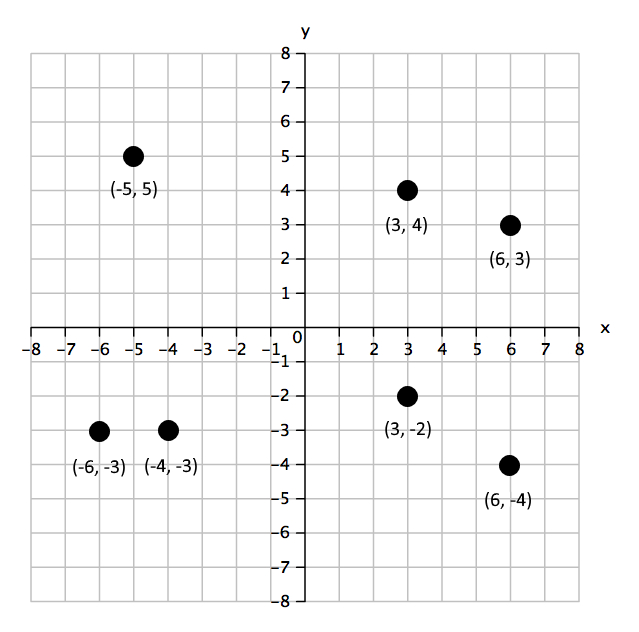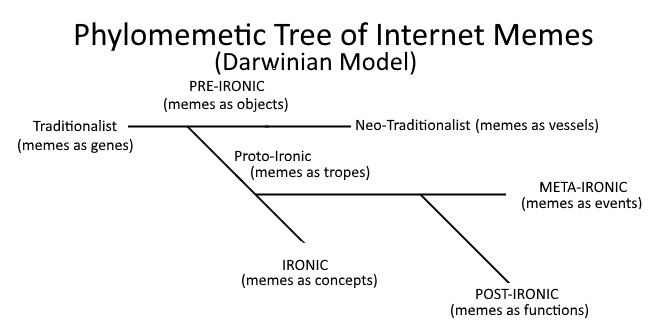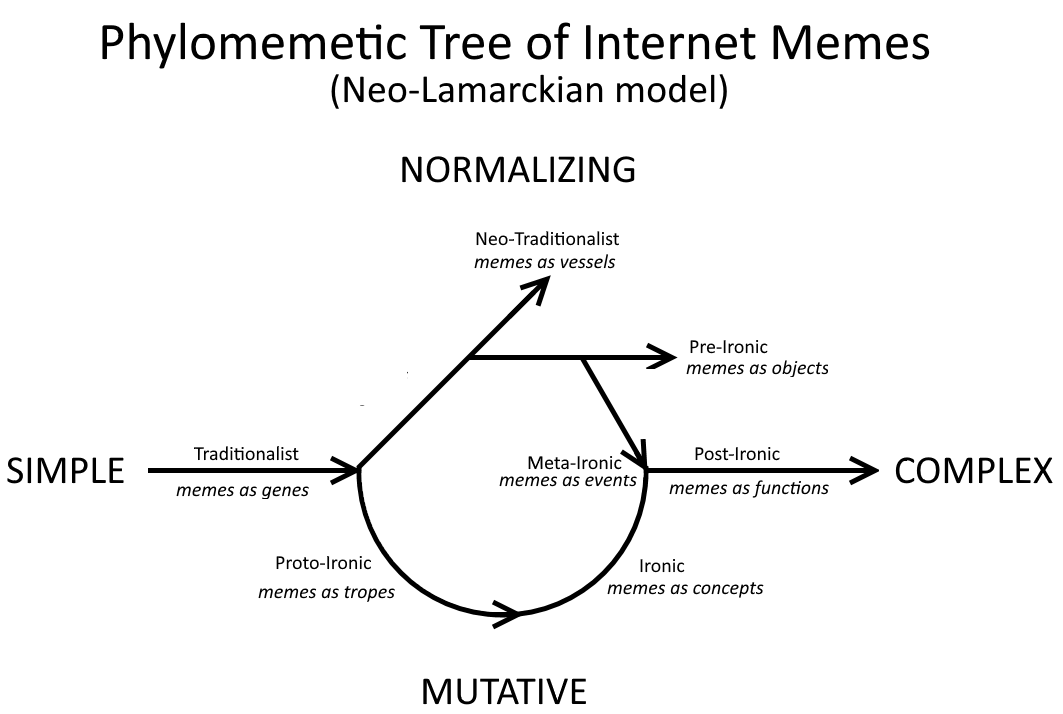Bane, Loss and Phylogeny
S. Y. HerI have been developing a theory of Internet Memes, through which I hope to operationalize memetics for the scientific analysis of Internet Meme culture. Here is a case study I used to test and develop some of my models.
An ‘Internet Meme’ is a particular kind of meme which spreads through networks of people connected by the Internet, as opposed to directly between person to person (or machine to machine). Just what a ‘meme’ might be—whether a it is literally ‘an abiological gene’ analogous to DNA or simply a useful unit of human behaviour for the discussion of the flow of culture—is not within the scope of this article and will be discussed in the forthcoming article on the operationalization of Internet Memes. Insofar as an Internet Meme exists only on the Internet, it is composed entirely of digitally stored information and exist as pictures, music, phrases or videos. The aim of this exercise is to argue that we have good reason to believe the best approach to understanding Internet Memes is not a cultural analysis but a biological one, the abiological nature of Internet Memes notwithstanding.
My current hypothesis is that Internet Memes are a natural experiment involving entire ecosystems of ‘art-organisms’ simulated in silico. Here I present several evolutionary models for the study and classification of these art-organisms, outlining the limitations of simple Darwinian models prevalent in memetics and presenting a superior alternative. I suggest that the tension between Mainstream Internet Meme culture and Underground Internet Meme culture is at the basis of the evolutionary history of Internet Memes: the Mainstream exerted a pressure towards normalization and conservation while the Underground exerted a pressure towards subversion and mutation. I believe that this dynamic of selective pressures has remained consistent through the entire history of Internet Memes, only varying in their relative magnitudes.
The two memes we will examine here are Baneposts and Loss Edits. Baneposting is a genus of references and parodies for the opening scene of movie The Dark Knight Rises; Loss Edits are a species of parodies based on a comic by Ctrl+Alt+Del. The former utilized many aspects of the original video such as the dialogue and filmography to create various and numerous derivatives, while the latter focused on simply referencing the overdramatic nature of the comic, resulting in increasingly minimalistic and obscure recreations of the original. As we shall examine here, Baneposting experienced far greater evolutionary success both in number and spread (into various habitats) while Loss Edits became antiquated and met with resistance whenever revivalism was attempted.
The Exploitable stage of Loss Edits (in which its characters were replaced with humorous substitutes) was pre-ironic, as they remained unaltered in their formalist approach as well as the one-dimensional narrative of 'making fun of Loss'. The comic was always about the original versus the edits, with the initial intent of Ctrl+Alt+Delete at the outset and the punchline at the end of the meme.
I briefly mentioned in a post on the page that Loss Edits will only survive through the same 'postmodern' adaptation as Baneposts. Loss Edits—even the most clever, minimalist examples—are a manifestation of the same singular concept of what a Loss Edit is. They bare the visual essence of the original comic.
Here is a 'pure', minimalist variant of Loss which can be expressed as (3, 4) (6, 3) (-5,5) (-6, -3) (-4, -3) (3, -2) (6, -4).

The transformation of the meme into the coordinates is the exposure of the conceptual nature of Loss Edits—note how conceptual art still relies on materiality for its full expression. All Loss Edits are a single meme-concept variously expressed but ultimately all belong to a single species with little memetic variance. Their art-concept is to be constructed 'Loss-wise'. This perhaps applies to all Narratologically Conservative memes (Pre-Ironic Memes to Ironic Memes).
The transition from the Pre-Ironic form of the original Loss comic into Ironic form of Loss Edits was the rejection of the original author's intent and the re-establishment of the seven plot point, '1;11/11;1_' layout of the four panel comic as a found art object qua conceptual 'object' (contra subject). All that which superficially resembles anything other than the intentionally created art object is an accident of misperception, as represented by comments from 'normies' not getting the joke.
The syntactic essence of Loss Edits is the seven plot point formula as visually expressed in any given Pre-Ironic to Ironic variant of the meme; its semantic essence is the form of the original comic, whose Ironic reiteration is the rejection of the original intent of the old author in favour of the new authors who have appropriated the original as found, conceptual art; and the pragmatic essence of Loss Edits is obscurity itself, in which only those who are in on the joke are afforded the ability to understand the new authors' intended meaning. The in-joke aspect has developed further, and the comment “I don't get it,” has become a meme in itself.
The abundance of exploitable components in the original canon of Baneposting is an insufficient explanation for Loss Edits falling behind in the progression towards Post-Irony, since the modernist parody approach has focused singularly on the visual aspect (as opposed to the obsessive deconstruction of the contingent, synthetic aspects in the Baneposters and their postmodernist approach) that tends towards “retinal art” which the proto-postmodernists and postmodernists so disdained. It's not that there isn't enough material to parody; it's that diversity of perspective is precisely not the point. The numerous variants are not the rhizomatic relativity of the postmodern, but the permissible irregularities of the sub-components making up the master narrative of Loss.
Consider the Lamarckian spread of Proto-Ironic and Ironic memes against the Darwinian, audience-artist interactive co-evolution of Pre-Ironic memes. The Darwinian co-evolution model works so well with Pre-Ironic memes because their sociotypical identity remains stable, persisting throughout each punctuated equilibrium between two distinct Internet memes. It works very well when we consider memes (especially traditional kinds) historically, and might look something like this:
 The Lamarckian model on the other hand posits that the use and disuse of traits determine inheritance. Ironic memes evolve essentially so, with increased use increasing the survivability of the constituent meme-concepts expressed sociotypically as an Internet Meme. The various iterations of the 'same meme' (even minute mutations such as reposts with compression, new captions or even a new platform) make up, in monophyly, a gradual progression towards the emergence of new memotypical species. Such acquired traits are passed onto the next 'generation' or copy; we have access, as memetic engineers, to the very fabric of an Internet Meme art-organism, whose memetic makeup we may manipulate through image editing in just a few clicks.
The Lamarckian model on the other hand posits that the use and disuse of traits determine inheritance. Ironic memes evolve essentially so, with increased use increasing the survivability of the constituent meme-concepts expressed sociotypically as an Internet Meme. The various iterations of the 'same meme' (even minute mutations such as reposts with compression, new captions or even a new platform) make up, in monophyly, a gradual progression towards the emergence of new memotypical species. Such acquired traits are passed onto the next 'generation' or copy; we have access, as memetic engineers, to the very fabric of an Internet Meme art-organism, whose memetic makeup we may manipulate through image editing in just a few clicks.
The result is a tendency and demand for increasing complexity, in classic Lamarckian fashion. Loss Edits were crippled by their skewed reliance on the Darwinian mode of brute competition which focused on an economy of proliferation and high fidelity, losing out to the low-fi strategy of Baneposting which satisfied the evolutionary demands of both the Mainstream (for consistency; through the reliance on a canonical blueprint of the original scene) and the Underground (for novelty; through a wider variety of creative interpretations). As such, the Darwinian model doesn't work very well when it comes to the infidelitous, Ironic memes of the Underground. Here is a model I propose instead:

The externalist theory of memes, which posits that memes exist independently of minds, becomes much more relevant as the focus of Internet Meme culture moves on from Pre-Irony into Irony and beyond. The memotypes spread cybernetically; their constituent memes ideated by brains, encoded and spread through the Internet as objects, to be decoded by other brains. The internalist theory (that memes exist only as features within human brains which spread from person to person via cultural exchange) quickly loses ground. For memes to spread, it is not necessary that everybody is in on the joke—hence the disparity in the dominant evolutionary strategies and pattern in the Mainstream and the Underground (Darwinian and Lamarckian, respectively) as shown in the Neo-Lamarckian model.
How a work of art or meme functions is constrained by the medium or vector through which it is materialized and transmitted. The Loss Edit is the crystalization of the political notion that there are extraneous aspects to a meme in contrast to its essence, which detract from its purity. The Underground Internet Meme culture's disdain for the Mainstream (or ‘normies’) is analogous to the conceptualist disdain for aesthetics, and finally resulted in the emergence of a sub-species of Loss Edits—inside jokes about people not getting the joke, and delight in deliberate obscurantism. Meanwhile, as the theoretical applicability for Internet Memetics shifted from the internalist design of memetics as pseudo-genetics in favor of the Lamarckian, the Underground Internet Meme culture continued onward in its progression towards the higher complexity of Post-Ironic memes.
Conceptualism is postmodernism par excellence—an attempt at the purification of art into the analytic (separated from the synthetic conventions of aesthetics). Art ceases to be works (to be finished by the author) and becomes instead texts (to be read by the audience), of specific information as the artist encoded and as the audience decodes. All the Ironic Meme iterations of the Loss comic make up a single conceptualist artwork that is the Loss Edit; a text, completed by the audience's interaction with the concept by creating new variants. The revivalism of Loss Edits and its adoption by Meme Pages and Ironics alike owes entirely to its exploitability and normie-proof exclusivity—a classically Darwinian adaptability. However there is yet unexplored potential in the ways of the Post-Irony, neglected by the monotonous dominance of the four panel, seven plot point formula. The Meta-Ironic self critique of the more recent pieces signal the opportunity for a reconciliation between the Ironic and Neo-Traditionalistic aspects of Loss Edits and its Lamarckian development into a set of Post-Ironic Memes of its own. By that stage they will no longer be a Loss Edits—their memotypes will have progressed far enough to warrant distinction as a separate species.